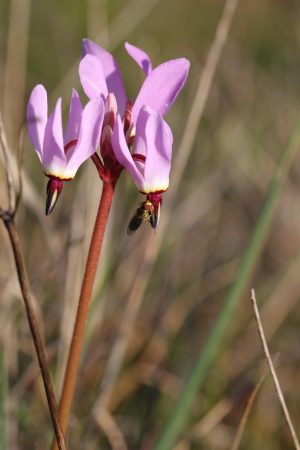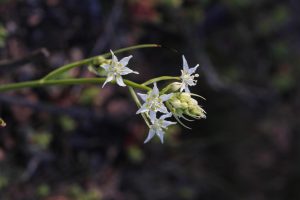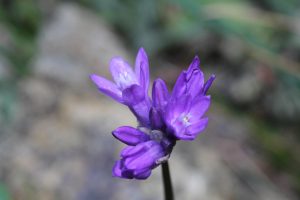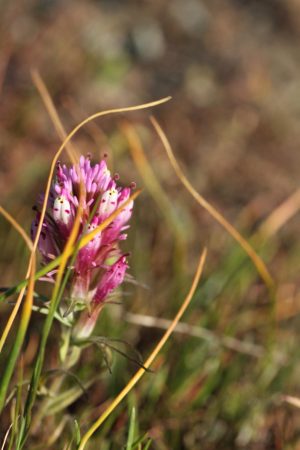Wildlife watch: Spring wildflowers to look out for
Early rains bring blooms of wildlflowers in Northern California
April 11, 2022
As spring unfolds, tiny hidden gems dot California’s renowned golden hills, now green with new life. Walking through our chaparral slopes and forests, one needs only to look more closely between blades of grass and thick brush to find our numerous native wildflowers.
The early rains in November and December triggered native plants to germinate earlier than usual, and as a result, many are blooming much earlier than in typical years. Unfortunately, a bone-dry January caused many early sprouters to dry out before flowering or bloom before their insect pollinators became active, exacerbating stress on native wildflower population levels. Still, there remain many wildflower species to enjoy this season. Parks like Edgewood County Park, Rancho San Antonio and San Bruno Mountain, just to name a few, harbor abundant biodiversity!
Be sure not to pick wildflowers. Our native plants are meant for everyone to admire, and preventing them from setting seed hurts already-dwindling populations. Below are four common grassland or chaparral-native plants now adorning our hillsides.

Primula hendersonii (Henderson’s shooting star)
This species belongs to a distinctive section of the primrose genus, Primula, called Dodecatheon. Species in sect. Dodecatheon have pendent flowers with dramatically reflexed petals, earning them the common name “shooting stars.” In a process called buzz-pollination, bees grab hold of the petals and vibrate their wings in order to shake the flower, which releases pollen from the pointed tip that comprises the anthers.

Toxicoscordion fremontii (Common starlily)
Common starlilies belong to a genus commonly known as deathcamas because they contain intensely toxic alkaloids. Indeed, the tribe of plants it falls under, Melanthieae, contains numerous species historically responsible for the poisonings of humans and grazing animals alike. Because of their potent lethality, the attractive, creamy flowers are pollinated only by specialist bees that tolerate their toxicity.

Dipterostemnon capitatus (Blue dicks)
A wide-ranging species, blue dicks thrive in a variety of habitats in the western United States. Like other members of the subfamily Brodiaeoideae, it perennially resprouts from a corm, which is an underground storage organ much like a bulb, and its flowers are arranged in an umbel—the pedicels, or flower stalks, radiate from a common central point. This species depends on periodic disturbances (such as those caused by fire) to maintain its populations, as it blooms most readily in open areas where other plants do not overly shade it.

Castilleja densiflora (Denseflower owl’s clover)
This showy species, which thrives in grassland and chaparral, belongs to the Orobanchaceae, a family that parasitizes other plants for nutrients. Like many other species in the family, Castilleja are hemiparasites, meaning they derive part of their nutrition from regular photosynthesis while simultaneously using modified roots called haustoria to penetrate the vascular system of host plants to rob them of nutrients. The vivid pink portions of this species’ inflorescence are in fact modified leaves called bracts, which surround the creamy pouchlike flowers.


















![“[Building nerf blasters] became this outlet of creativity for me that hasn't been matched by anything else. The process [of] making a build complete to your desire is such a painstakingly difficult process, but I've had to learn from [the skills needed from] soldering to proper painting. There's so many different options for everything, if you think about it, it exists. The best part is [that] if it doesn't exist, you can build it yourself," Ishaan Parate said.](https://harkeraquila.com/wp-content/uploads/2022/08/DSC_8149-900x604.jpg)




![“When I came into high school, I was ready to be a follower. But DECA was a game changer for me. It helped me overcome my fear of public speaking, and it's played such a major role in who I've become today. To be able to successfully lead a chapter of 150 students, an officer team and be one of the upperclassmen I once really admired is something I'm [really] proud of,” Anvitha Tummala ('21) said.](https://harkeraquila.com/wp-content/uploads/2021/07/Screen-Shot-2021-07-25-at-9.50.05-AM-900x594.png)







![“I think getting up in the morning and having a sense of purpose [is exciting]. I think without a certain amount of drive, life is kind of obsolete and mundane, and I think having that every single day is what makes each day unique and kind of makes life exciting,” Neymika Jain (12) said.](https://harkeraquila.com/wp-content/uploads/2017/06/Screen-Shot-2017-06-03-at-4.54.16-PM.png)








![“My slogan is ‘slow feet, don’t eat, and I’m hungry.’ You need to run fast to get where you are–you aren't going to get those championships if you aren't fast,” Angel Cervantes (12) said. “I want to do well in school on my tests and in track and win championships for my team. I live by that, [and] I can do that anywhere: in the classroom or on the field.”](https://harkeraquila.com/wp-content/uploads/2018/06/DSC5146-900x601.jpg)
![“[Volleyball has] taught me how to fall correctly, and another thing it taught is that you don’t have to be the best at something to be good at it. If you just hit the ball in a smart way, then it still scores points and you’re good at it. You could be a background player and still make a much bigger impact on the team than you would think,” Anya Gert (’20) said.](https://harkeraquila.com/wp-content/uploads/2020/06/AnnaGert_JinTuan_HoHPhotoEdited-600x900.jpeg)

![“I'm not nearly there yet, but [my confidence has] definitely been getting better since I was pretty shy and timid coming into Harker my freshman year. I know that there's a lot of people that are really confident in what they do, and I really admire them. Everyone's so driven and that has really pushed me to kind of try to find my own place in high school and be more confident,” Alyssa Huang (’20) said.](https://harkeraquila.com/wp-content/uploads/2020/06/AlyssaHuang_EmilyChen_HoHPhoto-900x749.jpeg)










